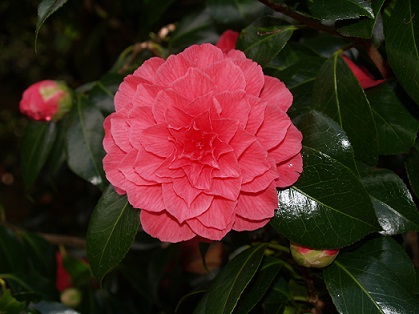Learn how to Grow Camellias
While many
Camellia species are highly adaptable, the best results are
generally achieved by choosing cultivars to suit the climate and
conditions you are growing them in. In this course, learn about the
different groups of camellias (e.g. japonicas, sasanquas, reticulatas),
their special characteristics, and their culture.
Develop your
understanding of soils, feeding, watering, pruning, planting methods,
pest & disease control, propagation, & more. Improve your
ability to identify different varieties (both common and uncommon), and
how to use camellias to achieve desired landscape effects.
This is a course for amateurs
and professionals; plant collectors, camellia enthusiasts, nurserymen,
landscapers, gardeners and horticulturists.

COURSE STRUCTURE
There are 8 lessons as follows:
- Introduction
- Culture
- Propagation
- Using Camellias
- The most Commonly Grown Varieties
- Other important Groups
- The Lesser Grown Varieties
- Special Assignment - On one selected plant or group.
Each lesson culminates in an assignment which is submitted to the
school, marked by the school's tutors and returned to you with any
relevant suggestions, comments, and if necessary, extra reading.
Duration: 100 hours
Learn to Recognise Differences between Different Types
Camellias belong to the plant family Theaceae. Reputable references may vary in the number of species attributed to the genus Camellia but today approximately 300 are described as species to include varieties of species and sub-species; there are also thousands of named cultivars. The following are the best-known species:
C. japonica has been bred widely to produce thousands of different flowering forms. C. japonica is best grown in temperate climates.
C. reticulata cultivars are generally more upright, with more open foliage and very large flowers, but not in the same quantity as the other two main types.
C. sasanqua has smaller flowers, but is more adaptable than others species. C. sasanqua will tolerate full sun and subtropical areas better than many others.
C. sinensis (the source of commercial tea) can be grown in tropical areas as a crop, or as an ornamental.
There are a lot of hybrids, and other species which are grown, but the four above have in the past been the most widely cultivated species. Nevertheless, we do touch on many more than just these four throughout this course.
Learn How to Grow Camellias
Most Camellias are relatively hardy plants once established. They usually prefer a protected position, with light to semi shade. There are some exceptions though:
- Even though most are hardy, some are not.
- Even though most resist frost, a few do not.
- Even though most tolerate damp spots, some don't.
- Although many will survive some dry spells once established, others don't.
- Although most grow in infertile soils, some don't.
Camellias prefer an acid, fertile, moist, but well drained soil. Light pruning can be done if necessary (after flowering) to keep the plants in shape. They respond well to mulching with rotted manures or compost. Tea-leaves can also be spread as a mulch after being used for brewing tea.
Camellias generally grow well in the shade of deciduous trees or among other woody shrubs of similar vigour. The optimum temperature for most species is 10-20 degrees C.